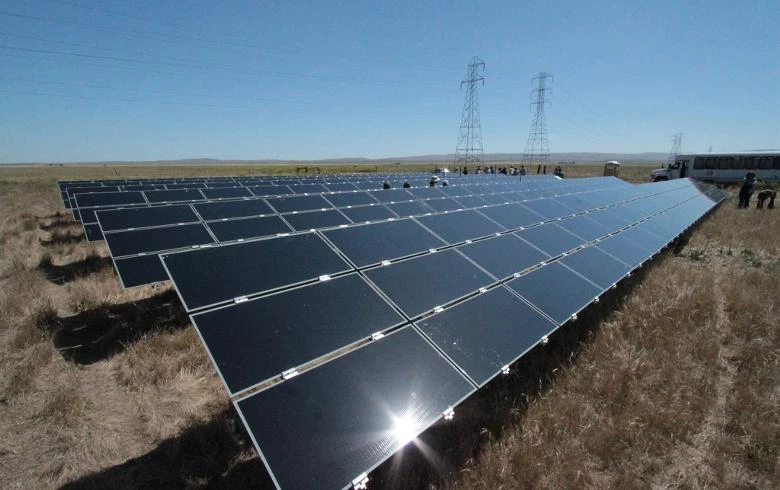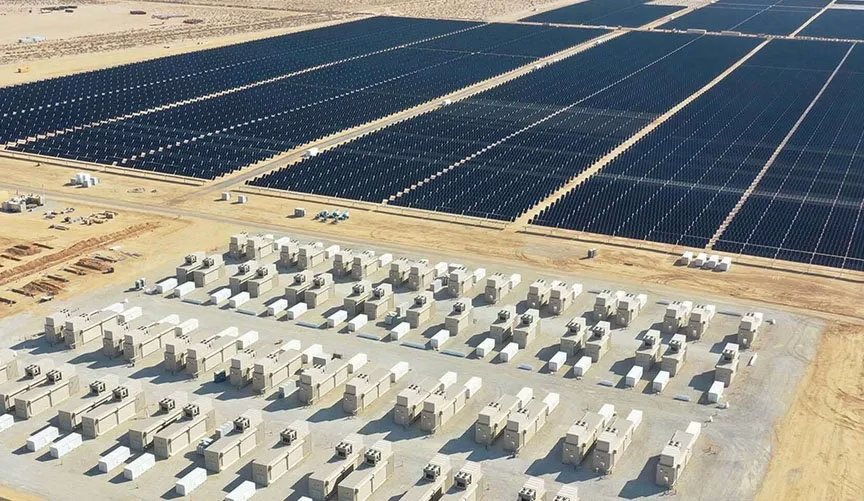California has emerged as the U.S. leader in solar-plus-storage, rapidly expanding both rooftop and utility-scale projects that pair photovoltaic generation with battery systems to store excess power for use during peak demand or outages. Battery capacity has soared from under 1 GW in 2020 to nearly 12 GW in 2024, enabling batteries to overtake gas as the state’s largest evening power source. Flagship projects like the Eland Solar-plus-Storage Center and Daggett Solar + Storage showcase this momentum, while policy shifts such as NEM 3.0 and generous incentives—including the 30% federal tax credit and California’s SGIP rebates—are driving both residential and commercial adoption. This integration is reshaping California’s energy mix, reducing reliance on fossil fuels, and strengthening grid resilience. In this article we take a look at the largest solar plus storage facilities in California.
Edwards & Sanborn (Kern County; Mojave Desert)
In early 2024, the Edwards & Sanborn project in California’s Mojave Desert officially became the largest solar-plus-storage facility in the United States.
Developed by Terra-Gen and built by Mortenson, the project spans 4,600 acres across Kern County and Edwards Air Force Base — the largest public-private partnership in U.S. Air Force history.
Key features include:
-
875 MWdc of solar power from 1.9 million First Solar panels
-
3,287 MWh of battery storage using over 120,000 units from LG Chem, Samsung, and BYD
-
400 miles of wiring connecting the entire system
-
10+ energy buyers, including PG&E, Southern California Edison, San Jose, Starbucks, and Clean Power Alliance
The project addresses a growing need: storing surplus solar energy for use during peak demand hours. As battery storage becomes essential to grid reliability, hybrid solar-plus-storage installations like this are setting a new standard in clean energy infrastructure.
Completion was announced in 2024, marking a major milestone for utility-scale renewables in the U.S.
Eland Solar Plus Storage (Mojave, Kern County)
Eland 1 was commissioned in December 2024, with 384 MW of solar and 150 MW (600 MWh) of storage under a $2 billion investment. Eland 2 has been completed in August 2025 and now brings the total capacity to approximately 758 MW of solar and 300 MW (1,200 MWh) of storage.
Daggett Solar Plus Storage (San Bernardino County)
Came online in late 2023, with 482 MW of solar and 280 MW (1,120 MWh) of battery storage. It serves over 75,000 Bay Area homes and reduces more than 1 million metric tons of CO₂ annually. A Phase 3 expansion is a planned phase to further increase the storage capacity. The project, developed by Clearway Energy Group and MCE, created over 500 union jobs and redeveloped a former power plant site.
Desert Quartzite (Riverside County)
Declared operational in February 2025 with 375 MWdc (300 MWac) of solar and 150 MWac of battery storage (4-hour duration). It supplies power to Clean Power Alliance under a 20‑year PPA. Once fully online, it will power over 163,000 homes and avoid more than 669,000 metric tons of CO₂ emissions annually.
In April EDF Renewables North America, a subsidiary of EDF Renewables announced the successful closure of ong term financing for the project. EDF Renewables is one of the leading solar energy developers in the USA.
Darden Clean Energy Project (Fresno County)
Approved by the California Energy Commission in June 2025 through a fast-track process. The Darden Clean Energy project will feature around 1.1 GW of solar and potentially a world-record 4,600 MW / 18,400 MWh battery storage system, enough to power 850,000 homes for four hours. It is scheduled for completion around 2027–2028, with more than 1,200 jobs anticipated.
Statewide Trends and Policy Backdrop
As of April 2025, California hosts around 13,000 MW of grid-connected battery storage, supporting 21 GW of solar generation. The state now regularly dispatches more battery energy than gas during evening peaks. Since Governor Newsom took office, storage capacity has grown from 770 MW in 2019 to over 10 GW by 2024. California targets 52 GW of battery storage by 2045 as part of its 100% clean electricity goal.
In June 2025, California used a 270‑day environmental review process to fast-track the Darden project, creating a precedent for speeding up permitting of large renewable energy projects.
Why These Projects Matter
These massive solar plus storage facilities are helping California move away from fossil fuels by delivering solar energy during evening hours and improving grid reliability. The projects are also helping reduce emissions and ensure a more stable energy supply. Many include multi-hour storage, which is crucial for meeting demand when the sun isn’t shining.
These developments showcase strong cooperation between developers, utilities, community energy providers, labor groups, and government regulators. They also bring significant local economic benefits through job creation and infrastructure upgrades.
Summary Table
| Project | Solar Capacity | Storage Capacity | Status | Notes |
|---|---|---|---|---|
| Edwards & Sanborn | ~875 MWdc | ~3,287 MWh | Online (2024) | Largest in U.S., multiple offtake partners |
| Daggett | 482 MW | 280 MW (1,120 MWh) | Online (2023) | Expansion underway, reuse of former power plant |
| Eland 1 & 2 | ~758 MW total | ~1,200 MWh | Phase 1&2 online | $2 b investment |
| Desert Quartzite | 375 MWdc (300 MWac) | 150 MWac (4‑hr) | Online (2025) | CPA power purchase agreement |
| Darden Clean Energy | ~1.1 GW | ~4,600 MW / 18,400 MWh | Approved June 2025 | World’s largest battery storage project |
Looking Ahead
With large-scale projects like Darden on the way, California is setting the pace for solar plus storage growth in the U.S. and globally. Continued policy support, fast-tracked permitting, and falling battery costs are key drivers of growth. California now routinely dispatches over 6,000 MW of battery power in the evening, making storage a central component of the state’s clean energy future.
California’s mega solar plus storage projects are creating a cleaner, more reliable, and more resilient energy system while delivering jobs, reducing emissions, and laying the foundation for a sustainable grid.


